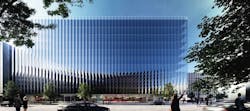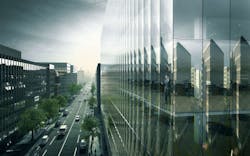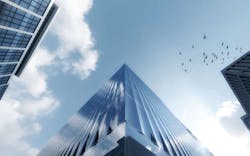Curved glass curtains will give Washington, D.C., office building more views and floor space
By Mike Chamernik, Associate Editor
The 2050 M Street building in Washington, D.C., will be covered with curtains of curved glass.
The building’s envelope will be composed of 900 floor-to-ceiling fluted glass panels that measure nearly 10.5 feet tall and 4.9 feet in width, according to Architizer.
The curved glass is thinner and more transparent than typical glass façades. It will not need intermediary mullions for support, which maximizes floor space for the 11-story, 364,000-sf building.
Joshua Prince-Ramus, the principal of New York-based firm REX, designed 2050 M Street, and it is commissioned by real estate company Tishman Speyer.
It will house offices and television studios for CBS’s Washington Bureau, and it will open in 2019. It is targeting LEED Gold certification.


